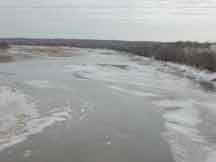Kansas Water Science Center
 Kansas River at DeSoto, January 21, 2003, discharge 317 cubic feet per second. Photograph by J. Barnard, USGS
Kansas River at DeSoto, January 21, 2003, discharge 317 cubic feet per second. Photograph by J. Barnard, USGS
USGS Water Science Centers are located in each state. 
|
Historic Droughts of KansasMonthly flows recorded at 63 gaging stations were used to analyze droughts in Kansas by evaluating the cumulative departures of monthly streamflows from long-term average monthly discharges for each of the station records. As a result of the analysis, five droughts were identified: 1929-41, 1952-57, 1962-1972, 1974-82, and 1988. The 1929-42 drought was regional in scale and affected many of the Midwestern and Western States. The recurrence interval was greater than 25 years throughout Kansas. Although the number of streamflow records long enough to include the entire drought was insufficient, data from adjoining States confirmed the severity. Agricultural losses during the 1929-41 drought were extreme, and many farms were abandoned. The drought of 1952-57 also was regional. The drought recurrence interval was greater than 25 years statewide except in the Big Blue River Basin, where the recurrence interval was 10-25 years. Because of its severity and areal extent, the drought of 1952-57 is used as the base period for studies of reservoir yields in Kansas. The duration of the 1962-72 regional drought varied considerably across the State. Many of the streamflow records indicated alternating less-than-average and greater-than-average flows, whereas others indicated a steady deficit throughout the entire period. Similarly, the drought of 1974-82 appeared to be a series of relatively short-duration droughts at several gaging stations but sustained or long-term droughts at others. During the 1962-72 drought, the recurrence interval generally was greater than 25 years. However, in parts of the northwestern, northeastern, southern, and southeastern areas of the State, recurrence intervals were 10-25 years. The recurrence interval of the 1974-82 drought was greater than 25 years in the north-central and southeastern parts but was between 10 and 25 years across the remaining eastern two-thirds of the State. Because of inadequate streamflow information for comparison, the severity of the 1974-82 drought could not be determined in the western one-third of the State. The severity of the 1988 drought varied across the State. The drought was most severe in the southwestern, central, and northeastern parts of the State but minimal in the northwestern and southeastern parts. At the beginning of the drought, reservoir storage was near or above average; hence, surface-water supplies were sufficient to meet demands through the end of water year 1988. Rainfall during the period generally was less than 50 percent of the long-term average, and quantities were insufficient to maintain soil moisture or contribute to ground-water supplies. The decreased soil moisture resulted in considerable damage to maturing grain crops, decreased the growth of forage grasses, and threatened the germination of the winter wheat crop. Estimated losses to 1988 crops resulting from the effects of the drought were $1 billion (Wichita Eagle and Beacon, June 7, 1989). Water levels in the shallow aquifers declined rapidly, which resulted in the abandonment of many domestic water wells. At the end of 1988, the effects of the drought were continuing to worsen. As a result, State and local officials were considering measures to decrease water use and were requesting financial relief for the agricultural industry. The drought of 1988 continued into the 1990's, but at a reduced level. In the fall of 1989 precipitation returned to near normal, and the spring of 1990 was somewhat wet. However, by the fall of 1990 it had dried out again and continued until July of 1992. It has continued to be on the wet side since the fall of 1992, except for a dry winter of 1995-96 and the current water year (2000). (Modified from Clement, R.W., 1991, Kansas floods and droughts, in Paulson, R.W., Chase, E.B., Roberts, R.S., and Moody, D.W., compilers, National water summary 1988-89 -- Hydrologic events and floods and droughts: U.S. Geological Survey Water-Supply Paper 2375, p. 287-294.) |